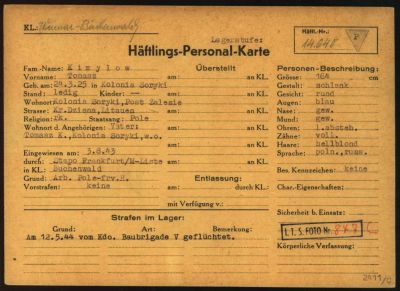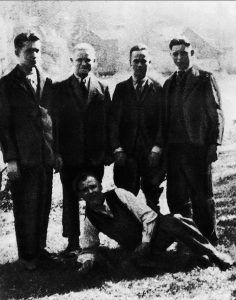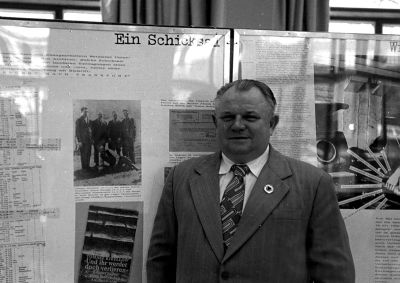Forced child labour in Hessen – The Story of Tomasz Kiryłłow

Even Polish children and young people were forced to work in the German Reich during the Second World War.[1] The specific case of a young man of Polish extraction has been remembered in Hessen since the 1980s. He had to work as a forced labourer in Wetzlar and was sent to what was then the “labour education camp” in Heddernheim (a district of Frankfurt am Main). His name was Tomasz Kiryłłow. The Wetzlar erinnert e.V. Association organised this commemorative work, with memorials and commemorative plaques erected in both Wetzlar[2] and Heddernheim[3], where the former “labour education camp” has become a memorial site. Even before the fall of the Berlin Wall, Tomasz Kiryłłow had travelled to Hessen from Poland to attend memorial ceremonies[4] in March /April 1987 because his memoirs had been published in Poland in 1980 and translated into German in the GDR in 1985[5]. On 1 April 1987 in the old Werner von Siemens School, as a guest of IG Metall [6], he recounted his experiences in Wetzlar (today Lahn-Dill district). Since the beginning of the 2000s, new publications[7] about the history of forced labour in Wetzlar have been published and since 2016 there has been a commemorative plaque[8] in the administrative centre of Lahn-Dill district, which remembers the forced labour in Wetzlar. Today, Wetzlar city council still keeps the memory[9] of the forced labour alive although it is not always clearly shown that Poles were also among the Russian, Belarussian and Ukrainian forced labourers.
Tomasz Kiryłłow, born on 24 March 1925 in Soryki (today Belarus), was part of this generation[10] of forced labourers. He was one of around 1.5 million children[11], who were forcibly removed from Poland and the Soviet Union[12] and taken to Germany as forced labourers during the Second World War. They worked in all areas of industry (even in the armaments industry), in agriculture, forestry and the domestic economy, in trades and in housekeeping. They worked for private and public employers and also within the framework of the Todt organisation[13].
[1] Macardle, Dorothy: Children of Europa. A Study of the children of liberated countries. Their war-time experience, their reactions, and their need, with a note on Germany, London 1949; Hrabar, Roman/ Tokarz, Zofia/ Wilczur, Jacek E.: Kinder im Krieg – Krieg gegen Kinder. Die Geschichte der polnischen Kinder 1939–1945, Reinbek bei Hamburg 1981; Mendel, Annekatrein: Zwangsarbeit im Kinderzimmer. ‘Ostarbeiterinnen’ in deutschen Familien von 1939 bis 1945. Gespräche mit Polinnen und Deutschen, Frankfurt a. M. 1994.
[2] Back in 1987, IG Metall initiated a memorial service in Wetzlar. In 2015, the Wetzlar erinnert e.V. Association designed a new exhibition about forced labour and created new information boards. https://wetzlar-erinnert.de/ns-zwangsarbeit/neue-ausstellung/tafel-1/ (last accessed on 27/06/2023).
[3] Krause-Schmitt, Ursula/ Freyberg, Jutta von (Publ.): Heimatgeschichtlicher Wegweiser zu den Stätten des Widerstandes und der Verfolgung 1933–1945. Volume 1/1: Hessen I. Regierungsbezirk Darmstadt, Frankfurt a. M. 1995, p. 127–131.
[4] In the 1980s, Tomasz Kiryłłow took part in a memorial ceremony in Heddernheim: cf. ibid, p. 129. In 2013, the City of Frankfurt redeveloped the former Heddernheim “work education camp”. New plaques were installed in 2018. https://lisa.gerda-henkel-stiftung.de/datensammlung_zum_arbeitserziehungslager_frankfurt_m._heddernheim?nav_id=4286 (last accessed on 27/06/2023).
[5] Kiryłłow, Tomasz: “Und ihr werdet doch verlieren”. Erinnerungen eines polnischen Antifaschisten [I tak przegracie wojnę], translated from Polish by Brümmer, Berlin 1985 [Warszawa 1980].
[6] https://wetzlar-erinnert.de/ns-zwangsarbeit/neue-ausstellung/tafel-5/ (last accessed on 27/06/2023).
[7] Pollemans, Piet J.: Als Zwangsarbeiter in Deutschland. Erinnerungen an die Jahre 1943-1945 in Rüsselsheim und Wetzlar, Rüsselsheim 2000. Porezag, Karsten: Zwangsarbeit in Wetzlar. Der “Ausländer-Einsatz” 1939–1945. Die Ausländerlager 1945–1949, Wetzlar 2002.
[8] https://wetzlar-erinnert.de/gedenken/gedenkorte/gedenktafelenthuellung-im-kreishaus/ (last accessed on 27/06/2023).
[9] https://www.wetzlar.de/rathaus/aktuelles/pressemitteilungen/archiv/2021/06_Juni/gedenken-an-zwangsarbeite.php?p=4021,3932,11407,4249,74465 (last accessed on 27/06/2023).
[10] In the historiography, various investigations are already available which use the tools of microhistory to focus on specific regions: e.g. Valentina Maria Stefanski on Leverkusen, Susanne Kraatz on Heidelberg, Margarethe Ruff on Vorarlberg, Thomas Muggenthaler on Bavaria, Margot Löhr, Herbert Diercks on Hamburg. Galina Knat’ko has also reseached the forced labour of Belarusian children in Austria. The research analyses different groups of youths from Poland and the Soviet Union (and from Ukraine). cf. Stefanski, Valentina-Maria: Zwangsarbeit in Leverkusen. Polnische Jugendliche im I.G. Farbenwerk, Osnabrück 2000; Kraatz, Susanne (Publ.): Verschleppt und vergessen. Schicksale jugendlicher “OstarbeiterInnen” von der Krim im Zweiten Weltkrieg und danach. Book accompanying the exhibition in Heidelberg town hall, Heidelberg 1995; Ruff, Margarethe: Minderjährige Gefangene des Faschismus. Lebensgeschichten polnischer und ukrainischer Zwangsarbeiterinnen und Zwangsarbeiter in Vorarlberg, Innsbruck/Vienna 2014; Muggenthaler, Thomas: “Wir hatten keine Jugend”. Zwangsarbeiter erinnern sich an ihre Zeit in Bayern, Viechtach 2003; Löhr, Margot: Die vergessenen Kinder von Zwangsarbeiterinnen in Hamburg. Ermordet durch Vernachlässigung und Unterernährung. Two volumes, Hamburg 2020; Diercks, Herbert (Publ.): Verschleppt nach Deutschland! Jugendliche Häftlinge des KZ Neuengamme aus der Sowjetunion erinnern sich, Bremen 2000; Knat’ko, Galina: Die Verschleppung weißrussischer “Ostarbeiter” zur Zwangsarbeit ins Deutsche Reich (1941-1944), in: Ludwig Boltzmann Institut für Kriegsfolgen-Forschung inter alia. (Publ.): “Ostarbeiter”. Weißrussische Zwangsarbeiter in Österreich. Dokumente und Materialien, Graz/Minsk 2003, p. 6–25.
[11] Steinert, Johannes-Dieter: Deportation und Zwangsarbeit. Polnische und sowjetische Kinder im nationalsozialistischen Deutschland und im besetzten Osteuropa 1939–1945, Essen 2013.
[12] Ibid, p. 11. Cf. Pohl, Dieter/ Sebta, Tanja (Publ.), Zwangsarbeit in Hitlers Europa. Besatzung – Arbeit – Folgen, Berlin 2013.
[13] This building unit of the Nazi state used forced labourers, prisoners of war and concentration camp prisoners for construction projects in the occupied territories during the Second World War.
The story of Tomasz Kiryłłow is absolutely typical for the generation born in the interwar period, with at least two cultures being brought together in his family, the Polish and the Belarusian. His family was living in the northeastern part of the Second Polish Republic, in Hlybokaje[14], when the Second World War began. His mother's family was Polish, he was baptised a Catholic and was given a Polish first name. By contrast, his father's family was Belarusian and orthodox. As well as Polish, Tomasz Kiryłłow could also speak Russian and Belarusian. The young Tomasz was also fluent in French because he had spent the first ten years of his life, until 1935, in Northern France. For financial reasons, his parents had migrated to the area near Lille and Valenciennes (Pas-de-Calais). Growing up multilingual and having varied language skills would later prove very important to Tomasz Kiryłłow’s survival strategies as a forced labourer.
As a 17-year-old adolescent, Tomasz Kiryłłow left the Belarusian Soviet Republic by train with other young people from his region at the start of 1943. Because he feared reprisals against his family if he refused the German diktat, he did not try to flee from forced labour in the German Reich. After a journey that took several days, he arrived in Hessen: The train’s final stop was Kelsterbach, southwest of Frankfurt. Finally, after arriving in Germany and spending a first night in a transit camp for “Eastern Workers”[15], Tomasz Kiryłłow and others travelled by train to the Lahn.
His first impression stirred memories of his childhood in France:
“We walked through the town. I liked the high, multi-level houses. To that point, none of us had seen such a beautiful town close up. Cars, motorbikes and bikes hurried over the wide asphalt streets. Well dressed pedestrians thronged along the pavements. The shops had large display windows.”[16]
It was in the camp in Wetzlar that he experienced for the first time what it was like to be addressed by a number and not by his name. Tomasz Kiryłłow also saw older foreign workers wearing the “OST” armband of the “Eastern workers”. From the very first day, he experienced what it meant to be surrounded by armed soldiers.
[14] Belarusian: Hłybokaje; Russian: Glubokoje; Polish: Głębokie.
[15] Because he had lived in the Belarusian Soviet Republic, he was categorised as an “Eastern worker”, whilst Poles were actually categorised differently and had to wear a “P”.
[16] Kiryłłow 1985, p. 39.
In Wetzlar, several companies employed forced labourers. In spring 1943, Röchling-Buderus had a “Polish camp” with 60 to 65 people; in 1944, there were various camps in Wetzlar for forced labourers[17], including a works camp with 88 Polish men and one Polish woman[18]. The 17-year-old Polish forced labourer Tomasz Kiryłłow had to work at Pfeiffer-Apparatebau which was arming the Luftwaffe. In the factory, he got to know discipline, violence, screaming and gruelling work. He was trained to be a lathe operator and worked all day on a lathe in the factory on the conveyor belt. Tomasz Kiryłłow went hungry in the factory just as he did in the camp. The forced labourers had to work 12 hours a day (except on Sundays).
As well as hunger, Tomasz Kiryłłow as a forced labourer also experienced blatant hatred in the German Reich:
“Tired, starved, with the degrading badge “OST” on our chests, we paraded through the streets of the town in a column, armed guards leading us once again. On the pavements, passers-by watched us disdainfully with open hostility. A boy who was perhaps seven years old spat in our direction. We didn’t understand where this hatred came from. We arrived in the camp dejected. We had a cursory wash and queued up for supper. We each were given half a litre of thin soup with a few potatoes in the bottom of the bowl.”[19]
Sadness, homesickness and emotional pain quickly became the bedfellows of hunger: “The hunger tortured us relentlessly. We longed for our parents and freedom.”[20] Apathy and an injury caused him to report to the camp hospital. Because he was working less and less and failing to meet the quotas set by the Germans, on 14 May 1943[21] Tomasz Kiryłłow was taken by the SS to the Heddernheim “labour education camp”[22] for alleged “sabotage”. He was regularly beaten. In his memoirs he recounts that weaker forced labourers were murdered in the camp infirmary:
“A few new ones were so intimidated that they worked quickly. They also became so tired that they could hardly move. Then they were beaten by the SS people with shanks and bull whips until, covered in blood and full of bruises, they lost consciousness. They were taken to the camp where they were given a lethal injection of carbolic acid.”[23]
On 3 August 1943, after six weeks’ ‘education detention’, he was removed and taken to Buchenwald concentration camp[24] as “work shy”; he was given prisoner number 14640.
[17] https://wetzlar-erinnert.de/ns-zwangsarbeit/neue-ausstellung/tafel-3/ (last accessed on 27/06/2023).
[18] Krause-Schmitt/ Freyberg 1995, p. 129.
[19] Kiryłłow 1985, p. 45.
[20] Ibid, p. 47.
[21] Ibid, p. 90.
[22] Cf. Wehe, Friedrich: Das Arbeitserziehungslager Frankfurt-Heddernheim, in: Bembek, Lothar/ Schwalba-Hoth, Frank/ DIE GRÜNEN im Landtag (Hessen) (Publ.): Hessen hinter Stacheldraht. Verdrängt und vergessen. KZs, Lager, Außenkommandos, p. 85–95. The memorial site is in Oberschelder Weg, where the Heddernheim “labour education camp” was located. Cf. https://www.lagis-hessen.de/de/subjects/idrec/sn/nstopo/id/4 (last accessed on 27/06/2023).
[23] Kiryłłow 1985, p. 88f.
[24] Index cards and individual prisoner papers about Tomasz Kiryłłow are spelt “Kirylow” in the data records of the International Tracing Service (ITS): Prisoner card Tomasz Kirylow, Buchenwald, 6271861, ITS Digital Archive, Arolsen Archives. Cf. https://collections.arolsen-archives.org/en/search/person/6271860?s=Kirylow&t=222836&p=1
Tomasz Kiryłłow was sent from Buchenwald prison camp to labour units in sub-camps. He weighed only 48 kilograms,[25] was ill and his legs were injured[26]. He doubted that he would survive. In May 1944, he worked in one of Buchenwald’s sub-camps in Northern France (Hesdin[27], construction brigade command V). He survived thanks to Polish, Soviet and French aid networks who provided him with additional food. On 12 May 1944, he finally managed to escape and joined the French Résistance. Thanks to the resistance movement in Northern France, he survived to the end of the war[28].
After the war, Tomasz Kiryłłow visited France and Germany from Poland several times to meet with former resistance fighters or forced labourers who he had met in Hessen and to look for other former prisoners from Buchenwald. His memoirs were first published in the People’s Republic of Poland in 1980, under the title I tak przegracie wojnę. The German translation Und ihr werdet doch verlieren. Erinnerungen eines polnischen Antifaschisten (1985), which appeared in the GDR in the Dietz-Verlag in Berlin, has of course also to be read against the background of a heroic narrative which deals with the communists’ fight against fascism, particularly in relation to Buchenwald, which was a symbol for the culture of remembrance of anti-fascism. The German publisher added comments to radicalise the political discourse of the text in this direction. But thanks to further historical research, today it is possible to compare this text with other statements from former forced labourers who were deported as children or as young people. A research project at the University of Wolverhampton[29] for example has evaluated 54 biographical interviews with former Polish forced child labourers.
There has been a commemorative plaque[30] in Wetzlar since 2019 in memory of Tomasz Kiryłłow.
Emmanuel Delille, July 2022
Further information:
https://wetzlar-erinnert.de/ns-zwangsarbeit/neue-ausstellung/tafel-4/
Video:
Tomasz Kiryłłow’s visit to Wetzlar in 1987, 30:21
https://www.youtube.com/watch?v=4OSrVPDbvrs
[25] Kiryłłow 1985, p. 103.
[26] His report on the hospital in Buchenwald is influenced by at least two statements which he read before he wrote his memoirs: Ostańkowicz, Czeslaw: Porażeni nie chcą umierać, Wrocław 1973; Zonik, Zygmunt: Opowieści z nieprawdopodobnego rewiru, Warszawa 1974. In this last book, it is the contemporary testimonies of a former deported doctor (Władyslaw Wikler) that horrified him. The significance of these testimonies is relative: there are many contemporary testimonies about the hospitals in Buchenwald, which were published in several European languages. These texts quote each other. They are retrospective narratives which are based both on other books and on the writers’ own memories.
[27] Cf. https://www.aussenlager-buchenwald.de/details.html?camp=101 (last accessed on 27/06/2023).
[28] Kiryłłow reports that the majority of the forced labourers of the Construction brigade command V, with whom he was taken to Hesdin in 1944, were murdered. Kiryłłow 1985, p. 194–195. Cf. Arolsen Archives.
[29] “Child Forced Labourers in Occupied Poland: Experiences, resilience and post-war discourses”, University of Wolverhampton, supported by the EVZ Foundation. Cf. Steinert 2013.
[30] https://www.hessenkolleg-wetzlar.de/2019/11/29/wir-erinnern-tomasz-kiryllow/ (last accessed on 27/06/2023); https://wetzlar-erinnert.de/gedenken/gedenktafeln/tomasz-kiryllow/ (last accessed on 27/06/2023).




